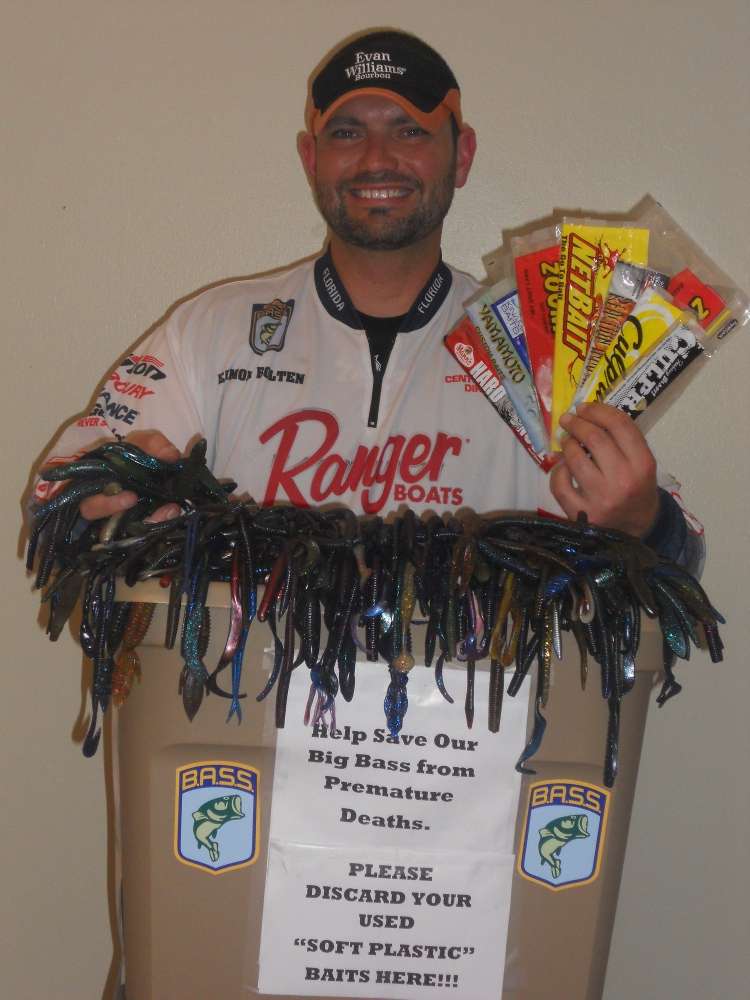
Angler Joe Ford’s chance discovery has re-energized the conservation spirit in bass anglers across the country.
B.A.S.S. founder Ray Scott first tapped into that extraordinary force 40 years ago, when he introduced catch and release to bass tournaments. Conservation-minded anglers quickly incorporated the practice into recreational fishing, and, within a few years, it became standard procedure for fishermen worldwide.
Will what Ford found in the stomach of a 10-pound largemouth spawn the second great stewardship campaign for which bass anglers become the standard bearers? That remains to be seen.
For the moment, though, it has motivated many within the ranks of B.A.S.S. to deal with a problem that has been too long ignored: The bottoms of our lakes are smothered with discarded plastic baits, and fish are eating them.
Ford hadn’t intended to keep the big bass that he caught while fishing Texas’ Lake Amistad. But because it was deep hooked, he put it in the livewell to see if it would survive. It did not.
As he was dressing it out, he noted a large plastic mass in its stomach. Closer examination revealed the blob to be a dozen plastic baits.
“It was amazing to see all of those worms in there,” he told me. “I don’t know how it was going to pass them.”
Possibly it wouldn’t have. A long bait, like a worm or lizard, can work its way into the intestine and stay there. And, because it is unable to feed, the fish could then could starve to death.
In my September B.A.S.S. Times Conservation column, I revealed Ford’s experience and explained the tragic scenario likely occurring below the surface of our fisheries. Response was instant.
Carl Wengenroth, owner of The Angler’s Lodge on in Del Rio, Texas, said he has seen plenty of skinny, sickly fish as he assists Texas Parks and Wildlife with fizzing and delayed mortality studies.
“We would see fish that look like a street roller ran over them,” he said. “Often, they’d die at the weigh-in. When we’d clean them, we’d find plastics in their stomachs.
“Then we started looking around and saw [plastic] worms at fish cleaning stations.”
But there was good news, too, as anglers immediately stepped up to be part of the solution instead of part of the problem.
In Arkansas, Randy Joe Heavin took his boater partner in a Central Open tournament to task for throwing baits overboard.
“I told him about the article in B.A.S.S. Times,” said Heavin, owner of Patriot Records. “And he said that he’d never really thought about it.”
The Oklahoma angler also recalled pulling up a mass of plastic worms from the bottom of DeGray Lake while jigging. “Other guys said that they were catching them too,” he recalled. “That’s when I realized that there must be a ton of them down there.”
Heavin added that he’s never thrown his used baits into the water. “But some guys get in the zone and don’t think about it.”
Not thinking about it is going to be tougher and tougher, thanks to B.A.S.S. Federation Nation state conservation directors.
Before a recent state tournament on Lake Toho, Florida’s Eamon Bolten talked to 128 participants about problems caused by discarded soft plastics and asked them to deposit their used baits in a collection box.
“Many anglers mentioned how they will now start putting their used baits in the collection box at the tournaments and stop throwing them away in trash cans or in the water,” the Florida conservation director said.
“At least five told me they used to throw their baits in the water and thought nothing of it until hearing me speak about the problems it can create for our bass.”
Up in South Dakota, Jeff Brown heard about Bolten’s program and decided to do the same in his state. “Our guys are extremely receptive to the idea,” he said.
At Amistad, Wengenroth not only collects used baits but remolds them into new ones. “We call the color ‘trash,’ and it seems to catch more fish,” he said.
“Doing something like that could be a great money maker for clubs,” he added. “And the big companies could get onboard and put a message on their packages to not discard baits.”
Now that the issue has been raised at a national level, many more ideas are being floated around in the angling community on how to deal with it. But whether enough fishermen will participate to effect fundamental change, as they did with catch-and-release, remains to be seen.

